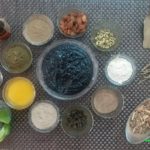Dysmenorrhea (or painful menstruation) means abdominal pain or cramps during or just before periods. It is one of the most common and incapacitating problems associated with monthly menstrual cycles among women. At times, more than the physical pain it’s the mental worry that plagues the woman fearing some underlying pathology to such painful episodes. Often you may think, ‘Why am I having such excruciating pains in periods.’ To answer that, 50% of the menstruating women, probably more, suffer from pain during periods. And there is nothing serious about it. But we surely need to know ways to get relief in period pains. In this article I will be sharing the reason behind pain during periods and natural remedies to overcome dysmenorrhea or painful periods.
Symptoms of Dysmenorrhea or Menstrual cramps
Normally menstrual cycle length of 28-35 days and bleeding duration of 4-5 days is considered as normal. Those who suffer from period pains, their cycle length may fall anywhere in between normal range and no significant relation is found between period cycle length and painful periods. However this is not true with the bleeding duration because those with bleeding duration of more than 5 days are often found to have painful periods. In other words, possibility of dysmenorrhea is greater in girls with longer periods. Let us have a look at the entire symptom picture of dysmenorrhea or painful periods.
- Onset of pain: Pain usually starts on day 1 of the menstruation. Very rarely it may begin 1 or 2 days prior to periods.
- Duration of pain: It varies a lot in different women. It may last for one or two days and very rarely on the third and fourth day of menses.
- Location of pain: Pain is mostly located in the lower part of the belly diffusely. However it may spread to lower back and thigh area too.
- Character of pain: It is mostly found to be spasmodic. Some women also experience shooting, piercing, stabbing or dull aching type of period pains.
- Severity of pain: It differs among women. Some may experience severe or excruciating or unbearable or incapacitating pains that may interfere with daily activities and absenteeism from school/college/work. While others may have moderate pains where one may carry out daily household chores with some difficulty. And those with mild pains have slight uneasiness but carries out daily activities without hindrance.
- Presence of clots: A research study concluded a strong association between dysmenorrhea and presence of blood clots1. Blood clots are usually present in those with painful periods.
- Family history of dysmenorrhea: It has been observed that period pains are common wherever family members (mother or sibling) has a positive history for dysmenorrhea.
- Associated or concomittant symptoms: Backache, headache, nausea, vomiting, constipation or diarrhea, bloating are some of the symptoms commonly associated with painful periods.
Risk factors of Dysmenorrhea or Menstrual Cramps
Women more likely to have painful periods are those with:
- Young age: Painful periods are commonly seen in young women less than 25 years of age. Dysmenorrhea improves as the age advances especially after child birth.
- Positive family history for painful periods: There is a strong association between painful periods and positive family history for it. It means that chances of having dysmenorrhea are more if family members (mother and sister) have painful periods.
- Early age at menarche: Women whose first periods started at an early age i.e. <12 years old are more likely to have painful periods.
- Heavy bleeding: Menstrual flow of longer duration or those with heavy bleeding are at greater risk of having dysmenorrhea.
- Smoking: Those who smoke cigarette are more likely to suffer from pain during periods.
- Depression and anxiety: There is a positive association between stress and painful periods.
Reason behind Dysmenorrhea or Menstrual Cramps
What causes menstrual cramps or period pains? A large role in the pathophysiology of dysmenorrhea is played by prostaglandins. Women with painful periods are found to have high levels of circulating prostaglandins. And the levels are highest during the first 2 days of menses. What are prostaglandins? Prostaglandins (PG) are compounds derived from long chain polyunsaturated fatty acids (PUFA) such as arachidonic acid. Let us understand how do Prostaglandins exert their effects in pain?
During the approach of menstruation, the progesterone levels drop and the endometrial cells lining the wall of uterus undergo shedding called endometrial sloughing. This triggers the release of prostaglandins (PG). As the level of PGs rise, the uterus undergoes contraction. These strong high amplitude and abnormal uterine contractions result in decreased blood supply to the uterine muscle cells, creating a state of hypoxia (Myometrial ischemia) and hence pain. In short, the contraction of the ischemic uterus under the influence of prostaglandins is most likely the reason behind dysmenorrhea.
Types of Dysmenorrhea or Menstrual Cramps
Dysmenorrhea is categorized into two types:
- Primary dysmenorrhea –Primary dysmenorrhea means painful menstruation without any underlying pathology. It is commonly seen in adolescent girls and originates soon after menarche. It usually improves as the age advances. Research studies have shown that pain reduces after childbirth. Proper history and physical examination is enough to make the diagnosis of primary dysmenorrhea.
- Secondary dysmenorrhea– Secondary dysmenorrhea is defined as painful menstruation associated with underlying causes like endometriosis, adenomyosis, pelvic inflammatory disease, ovarian cyst, polyps, fibroid, etc. Unlike primary dysmenorrhea, it is seen in older women (typically >25 yrs) and may originate at any point in life with an organic cause underneath. Women usually complain of associated symptoms such as pain during sexual intercourse (dyspareunia), bleeding after intercourse (postcoital bleeding), bleeding between two periods (intermenstrual bleeding), menorrhagia (heavy menstral bleeding). Apart from careful case history and physical examination, ultrasound is very useful in confirming the diagnosis of Secondary dysmenorrhea.
How will your doctor examine your Dysmenorrhea or Menstrual Cramps and what tests will be advised?
- During your doctor visit for menstrual cramps your doctor will ask you for your menstrual history which includes: Onset, location, duration and characteristics of pain along with any aggravating and ameliorating factors.
- It is important to understand that primary dysmenorrhea is common in adolescent girls and is without any underlying pathology.
- If you are an adolescent, pelvic examination will not be performed. For all other women pelvic examination (doctor inserts an instrument to see inside the vagina for any pelvic pathology) is done.
- A pelvic ultrasound may be advised if secondary dysmenorrhea is suspected.
How to relieve Dysmenorrhea (How to get relief in Menstrual cramps)?
- Pain-relief is the mainstay of dysmenorrhea treatment. There are many over-the counter medicines (Medicines for which you do not need doctor’s prescription) that can relieve period pains.
- Pharmacological methods of treating dysmenorrhea include NSAIDs (Non-Steroidal Anti-inflammatory Drugs) and oral contraceptives.
- Pain killers such as NSAIDS ( e.g. ibuprofen, aspirin) reduce period pains by suppressing the prostaglandin production.
- Contraceptive pills or birth control measures that contain progestin or estrogen prevents ovulation. Since primary dysmenorrhea takes place only in ovulatory cycles, these pills help in relieving menstrual pains. Birth control methods may also be available in the form of implant or injection.
- However, these medicines have side effects and are not well tolerated by many. For e.g. Ibuprofen and aspirin are not recommended in those with asthma and stomach, liver or kidney problems.
- A much safer and effective treatment for menstrual cramps is homoeopathic medicines and aromatherapy.
- To know about homoeopathic medicines that are effective in relieving menstrual cramps, please read my article on Homoeopathic medicines for dysmenorrhea or menstrual cramps.
Dysmenorrhea can try your patience especially if it calls for suspending important tasks every month. However remember that you are not alone in this journey and you should not feel deprived. It’s your body’s natural phenomenon which can be very well subdued with the correct medicine and few lifestyle changes.
References
- Kural M, Noor NN, Pandit D, Joshi T, Patil A. Menstrual characteristics and prevalence of dysmenorrhea in college going girls. J Family Med Prim Care. 2015;4(3):426–431. doi:10.4103/2249-4863.161345. [Pubmed]







Recent Comments